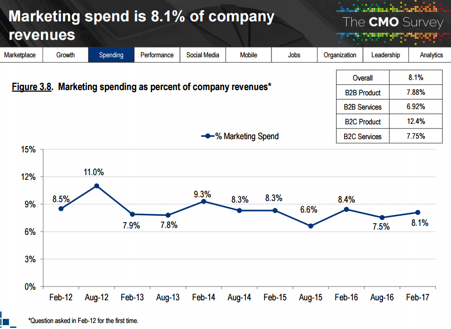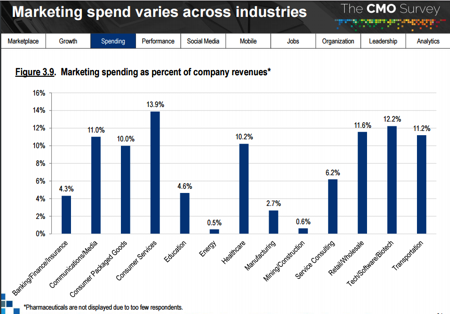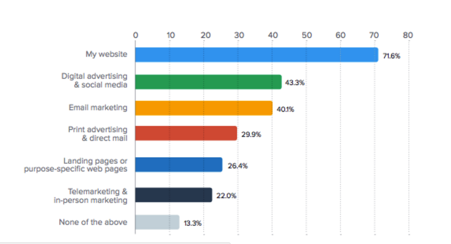How Much Should You Invest in B2B Marketing?

As many will attest, B2B marketing requires a very strategic approach. Unlike B2C, where you are only working to appeal to a single person, your messaging must adhere to a multitude of interests and concerns. When dealing with larger B2B organizations, there may be 5 people with whom your marketing strategy must speak:
- The Initiator – The original point of contact. In most cases, this is the office administrator or a department representative.
- The User – The person whose day-to-day routine will be directly impacted by your product or service.
- The Decider – The one who knows the exact criteria your product or service must meet in order justify a purchase. Normally, this is the head of a department.
- The Buyer – The person with the authority to make the final call. While this can sometimes be the department head, but most times, it’s the owner of the company, CEO or CFO.
- The Gatekeeper – The person you must pass through to get to the buyer. This will usually be an executive assistant.
Communicating a clear message that plays to the interests of all these people is no simple task. For smaller companies with limited resources, the margin for error can be extremely small. Therefore, it’s imperative that all facets of a marketing strategy work together so each dollar invested is used to the fullest extent.
Marketing as a whole is in a constant state of change. To remain competitive, you must keep up with the trends and be able to adapt accordingly.
So, how does a small company determine how much of their budget to invest in marketing? Unfortunately, there isn’t a one-size-fits-all solution as spending preferences vary from business to business. You can, however, use the following tips as a benchmark for determining your marketing budget:
1. Find Your Magic Number
Usually, the marketing budget is a percentage of your company’s revenue. Common wisdom on marketing spend is within a range of 8 to 10% of your revenue.. However, does this apply to small businesses like yours? The answer is an emphatic no!
According to the Gartner 2016-2017 CMO Spend Survey, marketing budgets have climbed to 8.1% of company revenue in Feb 2017. But the same survey also states that the marketing investment as a percentage of revenue varies by industry sector. The companies in the B2B product sector have 7.88% of their revenue on marketing.
 The survey also states marketing spend varies across industries. The top 3, in order, are:
The survey also states marketing spend varies across industries. The top 3, in order, are:
- The Consumer Service industry spends 13.9%
- Technology/Software/Biotechnology industries spend 12.2%
- Retail/Wholesale spends 11.6%.
 This suggests that the need for growth and the market competition are directly proportional to marketing spending. In short, if your company is a new player in a fiercely competitive industry, the benchmark cost for marketing may range anywhere between 10 to 20% of your revenue. However, for a small business, marketing spending goes well beyond just assigning a percentage and sticking with it. So, you need a concrete marketing strategy that will help you determine where and how much you need to spend to gain maximum exposure.
This suggests that the need for growth and the market competition are directly proportional to marketing spending. In short, if your company is a new player in a fiercely competitive industry, the benchmark cost for marketing may range anywhere between 10 to 20% of your revenue. However, for a small business, marketing spending goes well beyond just assigning a percentage and sticking with it. So, you need a concrete marketing strategy that will help you determine where and how much you need to spend to gain maximum exposure.
2. Think Long-Term
Unlike the big shots in your industry, you don’t have the resources for trial-and-error. In other words, you can’t afford to test a new marketing method and see if it works. It is, therefore, better for small businesses to go for proven long-term marketing strategies. Running a short-term marketing campaign is relatively difficult because the short-lived success will evaporate into thin air if you run out of money or labor during the campaign. Besides, most short-term marketing plans rely on paid marketing tools that can eat into your small budget.
On the other hand, a well-thought-out long-term marketing plan will continue to generate revenue even if you discontinue investing in it. It will also help a small business organization with an appetite for growth to generate strong leads. Take content marketing, for example. It is a proven long-term marketing strategy that will continue to generate revenue long after you have invested in content production. Usually, long-term marketing strategies require less investment compared to the short-lived campaigns. And they offer better results.
3. Calculate Your Expected ROI
Before you start with budgeting, it is important to know the potential outcome or ROI return on investment of your marketing strategies. As your business grows, your marketing strategies will evolve and the expected ROI will also change. In fact, the definition of ROI will change depending on the size of your company, and the type of marketing channel and industry.
For example, in the formative years, you may struggle to get new clients. So, the number of new lead generations will be your ROI at this stage. However, in the later years, you might struggle to keep up with the demand, making nurturing your leads your ROI. That’s why, measuring your ROI is a tedious task.
However, once you have mastered the technique to calculate the ROI, it will help you align your marketing strategy, processes, and operations to gain maximum exposure. Measuring your marketing ROI not only helps you look at the past to see what worked and what didn’t, but also helps plan the future campaigns. Stats from HubSpot show that 72% of organizations that calculate ROI say their marketing strategy is effective.
4. Consider Your Growth Goals
Before you start with budgeting, it is important to determine the business goals. The goals change as your business grows. In the formative years, you may struggle to get new clients, while in the later years, you might struggle to keep up with the demand and supply chain. Marketing strategies must also change with time and so should marketing budgets.
Marketing leaders must evaluate the growth goals and then create strategies that are relevant to the current marketing trends and user preferences. Adapting to change in terms of strategizing and budgeting is important to ensure success of the organization. Change management, in such cases, must be considered as one of your crucial growth strategies.
Change management helps marketers to rethink how to gain prescient adaptability. This usually includes aligning your marketing strategy, process, operations and structures with people and content. This, in turn, helps you improve your accountability as well as engagement.
However, simply adding new tools and platforms in the name of marketing change management is not enough. It is also essential to add new strategies and tactics to support these new tools. At times, you may need to reexamine your process flow and structure as well as your decision points to deliver the necessary results.
By encouraging your leaders to learn change management, you can help them assess the changing user needs and decide what new techniques and technologies need to be invested in to ensure better results. This will also help them decide what kind of marketing budget to allocate to achieve specific goals.
5. Consider Industry Trends
Once you have decided on your marketing spend, the next step is to work out how much you will spend on different marketing channels. For this reason, you must ALWAYS be keeping up with the latest marketing trends in your industry or niche to see which marketing channels are currently popular.
As a general rule of thumb, your company website is the central hub for all of your marketing efforts. Skimping in this area can turn out to be one of the deadliest sales killers to your entire strategy.
According to a report from Infusionsoft, most SMEs are likely to allocate more budget spend for investing in their websites and social media in 2018, followed by print advertising and direct mail.
 However, whether you should invest more money in the same channels where competition is fierce or go with the ones with lower competition is a matter of debate. Sometimes, what works for other people may not work for you. So make your decision based on the channels that worked and didn’t work for you in the past.
However, whether you should invest more money in the same channels where competition is fierce or go with the ones with lower competition is a matter of debate. Sometimes, what works for other people may not work for you. So make your decision based on the channels that worked and didn’t work for you in the past.
6. Spend Less and Make More
Though marketing is an essential part of your business, it is one of the most expensive parts as well. So as a small business, you will be interested in reducing your marketing costs by whichever means possible. Unfortunately, most small enterprises fall into a common trap when trimming marketing costs. They often cut back marketing expenses when the times are tough. Doing so can seriously jeopardize your marketing goals and even threaten the very existence of your company.
So, instead of cutting back, examine all your existing marketing channels and focus your resources on the ones that are bringing in the most qualified leads. Focusing your marketing resources on less expensive organic marketing channels will not only generate significant buzz, but also help maintain contact with your customer base in the long term. Another way to reduce marketing costs and increase your leads is to use free alternatives to high-tech marketing tools and software.
In Conclusion
When it comes to marketing, you have to invest money to make money. The more you invest, the better it is. However, many companies don’t have the luxury to spend handsomely on their marketing budget – least of all small businesses that have neither manpower nor money. It is, therefore, crucial for a small business to spend wisely and get the most out of free resources. Though your budget will increase as you meet your business goals, these tips will help you get a head start.
Have you tried any different approaches other than the ones described here? Please share, in the comments.
Featured image: Copyright: ‘https://www.123rf.com/profile_scanrail‘ / 123RF Stock Photo
Sign Up For Our Mailing List
To receive more in-depth articles, videos and Infographics in your inbox, please sign up below

Sign up for the newest articles from Curatti, delivered straight to your inbox
Latest posts by Dipti Parmar (see all)
- How AI in Martech Impacts the Customer Journey - January 28, 2021
- 4 Secrets for an Exceptional B2B Content Marketing Strategy - June 19, 2018
- How Much Should You Invest in B2B Marketing? - July 19, 2017
